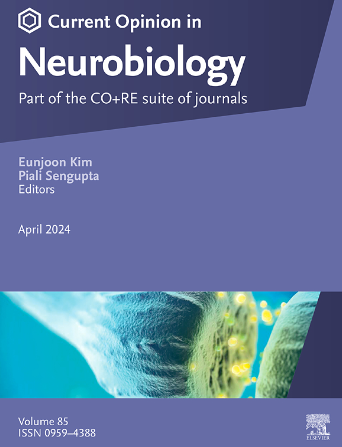“Arc – A viral vector of memory and synaptic plasticity”
IF 5.2
2区 医学
Q1 NEUROSCIENCES
引用次数: 0
Abstract
Learning induces gene expression and memory consolidation requires new protein synthesis. Many of these activity-induced genes are transcription factors. One of the exceptions is a key immediate early gene, Arc, which has been implicated in several forms of synaptic plasticity and is critical for long-term memory formation. Recently, Arc was discovered to have retroviral properties, such as the ability to form virus-like capsids, that were repurposed from an ancient retrotransposon. Arc capsids are released in extracellular vesicles that mediate intercellular communication. Here, we review Arc’s role in synaptic plasticity and propose a model for how Arc mediates memory consolidation via a novel intercellular non-cell autonomous form of long-term depression.
Arc -记忆和突触可塑性的病毒载体
学习诱导基因表达,记忆巩固需要新的蛋白质合成。这些活性诱导基因中有许多是转录因子。一个例外是一个关键的即时早期基因Arc,它与几种形式的突触可塑性有关,对长期记忆的形成至关重要。最近,Arc被发现具有逆转录病毒的特性,比如形成病毒样衣壳的能力,这是由一个古老的逆转录转座子改造而成的。Arc衣壳在细胞外囊泡中释放,介导细胞间通讯。在这里,我们回顾了Arc在突触可塑性中的作用,并提出了Arc如何通过一种新的细胞间非细胞自主形式的长期抑郁介导记忆巩固的模型。
本文章由计算机程序翻译,如有差异,请以英文原文为准。
求助全文
约1分钟内获得全文
求助全文
来源期刊

Current Opinion in Neurobiology
医学-神经科学
CiteScore
11.10
自引率
1.80%
发文量
130
审稿时长
4-8 weeks
期刊介绍:
Current Opinion in Neurobiology publishes short annotated reviews by leading experts on recent developments in the field of neurobiology. These experts write short reviews describing recent discoveries in this field (in the past 2-5 years), as well as highlighting select individual papers of particular significance.
The journal is thus an important resource allowing researchers and educators to quickly gain an overview and rich understanding of complex and current issues in the field of Neurobiology. The journal takes a unique and valuable approach in focusing each special issue around a topic of scientific and/or societal interest, and then bringing together leading international experts studying that topic, embracing diverse methodologies and perspectives.
Journal Content: The journal consists of 6 issues per year, covering 8 recurring topics every other year in the following categories:
-Neurobiology of Disease-
Neurobiology of Behavior-
Cellular Neuroscience-
Systems Neuroscience-
Developmental Neuroscience-
Neurobiology of Learning and Plasticity-
Molecular Neuroscience-
Computational Neuroscience
 求助内容:
求助内容: 应助结果提醒方式:
应助结果提醒方式:


